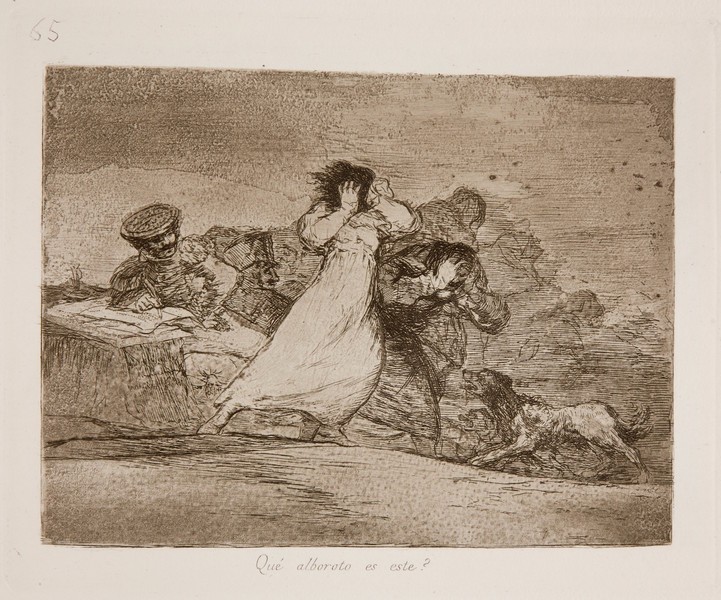- Cronología
- Ca. 1820 - 1823
- Dimensiones
- 180 x 221 mm
- Técnica y soporte
- Aguafuerte, aguatinta bruñida y/o lavis, buril y bruñidor
- Reconocimiento de la autoría de Goya
- Undisputed work
- Ficha: realización/revisión
- 22 Dec 2010 / 24 May 2023
- Inventario
- 225
See Sad forebodings of what is to come.
The title of the print was handwritten by Goya on the first and only series known to us at the time of its production, which the painter gave to his friend Agustín Ceán Bermúdez. Thus the title was subsequently engraved on the plate without any modification from Ceán Bermúdez's copy for the first edition of Disasters of War published by the Royal Academy of Fine Arts of San Fernando in Madrid in 1863.
No preparatory drawing has survived.
The last sixteen prints in the series of Los desastres de la guerra constitute what is called in the original title of Ceán Bermúdez's album Emphatic Caprices. In them, through symbolism that is often difficult to decipher and almost hermetic, perhaps because of the harshness of its content, Goya openly criticises the regime of Ferdinand VII (San Lorenzo of El Escorial, 1784-Madrid, 1833), who reigned from 1813 until his death. To a certain extent, the critical sense of the emphatic Caprichos allows us to interpret them as a return to Goya's first great series, Los Caprichos, in which the Aragonese artist questioned many aspects of the politics and society of his time.
In the engraving in question, a soldier who is writing stops his work to watch two women, one dressed in white and the other in black, being harassed by two furious dogs. The women are shaking and placing their hands in their hair, which is blown by the wind. Behind these two female figures, Goya has recorded other people in a mist who seem to be queuing up behind them.
This is a rather dark print in which Goya used aquatint. He has etched the figures and created an important contrast between the light clothes of the woman in the centre and the darker clothes of the woman next to her.
There are various explanations for the meaning of this engraving. For Enrique Lafuente, print no. 65 is the transition between those reflecting the horrors of war and the emphatic caprices in which Goya criticises Spanish society and the political scene after the war. The women are holding their hands over their heads because, according to Lafuente, they are receiving the news of their ruin, decreed by the invader who took various measures to strip the population of their crops or their money and thus obtain support for the army.
Jesusa Vega relates the scene to the departure of the French from Madrid, provoked by the entry of General Wellington and his troops. She also points out that if we look closely at the following prints we can understand that Goya is referring to what happened on 27 May 1813 when the French finally left Madrid. He also explains that it is difficult to know which army this soldier belonged to, as the uniform he is wearing was worn by the French, although it was also characteristic of the Logroño militia.
The plate is in the National Chalcography (cat. 316).
-
De grafiek van GoyaRijksmuseum RijksprentenkabinetAmsterdam1970from November 13th 1970 to January 17th 1971cat. 85
-
Francisco de GoyaMuseo d'Arte ModernaLugano1996exhibition celebrated from September 22nd to November 17th.cat. 65
-
Francisco Goya. Sein leben im spiegel der graphik. Fuendetodos 1746-1828 Bordeaux. 1746-1996Galerie KornfeldBern1996from November 21st 1996 to January 1997cat. 155
-
Goya artista de su tiempo y Goya artista únicoThe National Museum of Western ArtTokyo1999from December 1st to July 3th 1999p. 316
-
Francisco Goya. Capricci, follie e disastri della guerraSan Donato Milanese2000Opere grafiche della Fondazione Antonio Mazzottacat. 145
-
Goya. La imagen de la mujerMuseo Nacional del PradoMadrid2001from October 30th 2001 to February 10th 2002. Exhibitied also at the National Gallery of Art, Washington, March 10th to June 2nd 2002, consultant editor Francisco Calvo Serrallercat. 112
-
Goya et la modernitéPinacothèque de ParisParís2013from October 11st 2013 to March 16th 2014cat. 104
-
2022
-
Goya, grabadorMadridBlass S.A.1918cat. 167
-
Goya engravings and lithographs, vol. I y II.OxfordBruno Cassirer1964cat. 185
-
Vie et ouvre de Francisco de GoyaParísOffice du livre1970cat. 1104
-
Catálogo de las estampas de Goya en la Biblioteca NacionalMadridMinisterio de Educación y Cultura, Biblioteca Nacional1996cat. 280
-
ParísPinacoteca de París2013p. 152
-
Goya. In the Norton Simon MuseumPasadenaNorton Simon Museum2016pp. 114-151
-
Museo de Bellas Artes de Badajoz y Diputación de Badajoz2022p. 85
